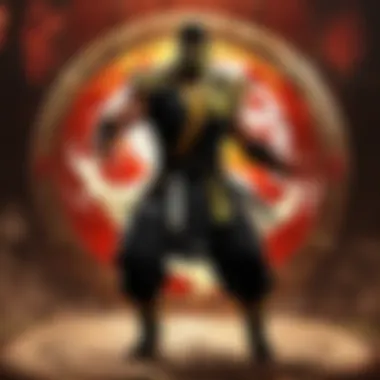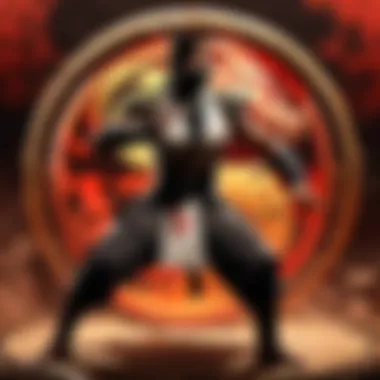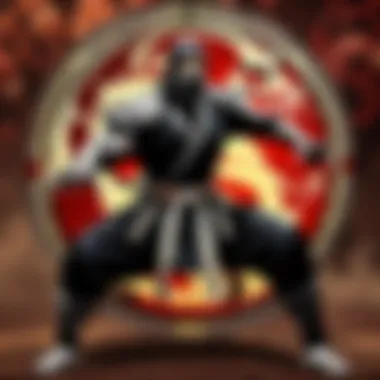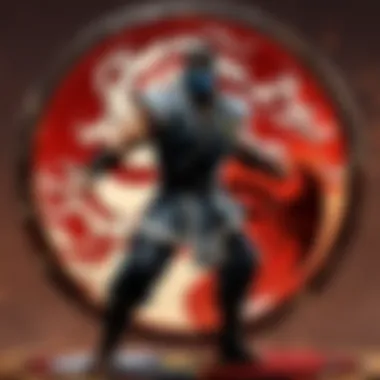Discover Small Circle Jujitsu Training Near Me for Martial Arts Enthusiasts


Character Profiles & Movesets
Small Circle Jujitsu is a fascinating martial art with a rich history and a diverse range of techniques. Originating in Japan, it has gained popularity worldwide for its emphasis on leverage and efficient movements. The practitioners of Small Circle Jujitsu are known for their quick footwork and precise executions. Signature moves like joint locks, pressure points, and throws are hallmark techniques in this art, requiring years of dedication to master.
Gameplay Strategies & Tactics
When delving into the intricacies of Small Circle Jujitsu, practitioners must understand the importance of strategic thinking and tactical execution. This martial art is not just about physical strength but also about mental acuity and adaptability. Practitioners must develop a keen sense of timing and anticipation to counter opponents effectively. Mastery of defensive and offensive strategies is crucial to excel in Small Circle Jujitsu, ensuring that every move is calculated and precise.
Storyline & Lore Explorations
Exploring the narrative behind Small Circle Jujitsu unveils a tapestry of stories and traditions passed down through generations. Understanding the historical context and cultural significance of this martial art adds depth to the practice. Dive into the lore of Small Circle Jujitsu to unravel the connections between its techniques and the values embedded in its philosophy. From ancient origins to modern adaptations, the storyline of Small Circle Jujitsu is as intricate as its techniques.
Updates & Patch Notes
Keeping abreast of the latest developments in Small Circle Jujitsu is essential for practitioners aiming to stay at the forefront of this dynamic art. Regular updates, patches, and new techniques can significantly impact gameplay strategies and training routines. Analyzing the changes introduced in each update provides valuable insights into the evolving landscape of Small Circle Jujitsu. Comparing pre and post-patch gameplay mechanics offers a nuanced understanding of the art's evolution and ensures that practitioners are well-equipped to adapt to new challenges.
Understanding Small Circle Jujitsu
Small Circle Jujitsu serves as a profound discipline within the martial arts realm, honing individuals physically and mentally. The amalgamation of precise techniques and profound philosophies distinguishes it within combat arts. Its emphasis on joint locks, balance strategies, and minimal effort showcases a unique approach to self-defense. Mastering Small Circle Jujitsu extends beyond physical capability to mental acuity, promoting quick thinking and strategic responses in confrontations.
History and Origins
Japanese Roots
The Japanese origins of Small Circle Jujitsu spotlight its rich history and cultural significance. Rooted in the ancient traditions of Japan, Small Circle Jujitsu inherits a legacy of combat prowess from samurai warriors. The incorporation of traditional Japanese martial arts forms the foundation of its techniques, emphasizing precision and efficiency in each movement. This historical background infuses Small Circle Jujitsu with authenticity and depth, attracting practitioners seeking a traditional yet effective martial art.
Development of Small Circle Concepts
The evolution of Small Circle Concepts revolutionized the martial arts landscape, introducing innovative principles that redefine combat strategies. Developed by Professor Wally Jay, these concepts prioritize fluid motions and minimal force for maximum impact. The incorporation of biomechanics and anatomical leverage sets Small Circle Jujitsu apart from conventional martial arts, providing practitioners with a nuanced understanding of human physiology. This strategic approach appeals to individuals seeking a practical and scientifically grounded self-defense system.
Philosophy and Principles
Efficiency and Minimal Effort
The philosophy of efficiency and minimal effort lies at the core of Small Circle Jujitsu, emphasizing the importance of conserving energy and executing techniques with precision. By leveraging anatomical weaknesses and optimal leverage points, practitioners can subdue larger opponents with minimal force. This principle aligns with the concept of using intelligence and strategy over brute strength, making Small Circle Jujitsu an ideal discipline for individuals of all body types and strengths.


Joint Locks and Manipulation
The mastery of joint locks and manipulation techniques defines Small Circle Jujitsu's combat effectiveness, providing practitioners with the ability to control and immobilize opponents swiftly. By targeting vulnerable joints and applying pressure in specific directions, practitioners can neutralize threats without causing severe harm. This focus on joint manipulation not only enhances self-defense capabilities but also promotes a deep understanding of human anatomy and kinetics, fostering a holistic approach to combat strategies.
Key Techniques
Wrist Locks
Wrist locks represent a fundamental aspect of Small Circle Jujitsu, showcasing the art's emphasis on precise and swift movements. By manipulating the wrist joint in various directions, practitioners can dictate an opponent's movements and establish control during confrontations. Wrist locks serve as versatile techniques suitable for a range of self-defense scenarios, from deflecting strikes to immobilizing aggressors.
Control and Balance Strategies
Control and balance strategies form the cornerstone of Small Circle Jujitsu's defensive arsenal, enabling practitioners to respond effectively to varying degrees of aggression. By understanding the dynamics of balance and leverage, individuals can exploit their opponent's vulnerabilities with calculated precision. These strategies not only enhance defensive capabilities but also cultivate a heightened sense of spatial awareness and strategic thinking in practitioners.
Benefits of Small Circle Jujitsu
Small Circle Jujitsu offers a multitude of benefits to its practitioners, making it a highly sought-after martial art. One of the key advantages of Small Circle Jujitsu is its emphasis on self-defense proficiency. Through specialized techniques and training, practitioners develop the skills necessary to protect themselves in various situations. This aspect is crucial for individuals seeking to enhance their self-defense capabilities and feel more empowered in potentially threatening scenarios.
Self-Defense Proficiency
Effective in Close Combat
The effectiveness of Small Circle Jujitsu in close combat scenarios is unparalleled. By focusing on close-quarters techniques that utilize joint locks and manipulation, practitioners can neutralize opponents even in confined spaces. This ability to control an opponent in tight situations sets Small Circle Jujitsu apart as a practical and efficient self-defense method. Its adaptability in close combat situations allows practitioners to quickly respond to threats and subdue adversaries effectively.
Adaptability in Various Situations
Another notable aspect of Small Circle Jujitsu is its adaptability in various situations. Whether facing multiple attackers or dealing with unpredictable assaults, practitioners are trained to assess and respond accordingly. This adaptability instills confidence and quick thinking, essential qualities for effective self-defense. Being prepared for a range of situations enhances a practitioner's overall self-defense proficiency, making Small Circle Jujitsu a well-rounded martial art choice.
Physical and Mental Fitness
Small Circle Jujitsu not only enhances self-defense skills but also promotes physical and mental well-being. Improved flexibility and coordination are key benefits of regular practice. Through repetitive movements and training exercises, practitioners develop agility and muscle memory, essential for executing techniques with precision. Additionally, the emphasis on stress relief and focus in Small Circle Jujitsu helps practitioners attain mental clarity and concentration, benefiting both their martial arts performance and daily life challenges.
Improved Flexibility and Coordination
The rigorous training routines in Small Circle Jujitsu lead to improved flexibility and coordination. Practitioners engage in dynamic stretching and coordination drills that enhance range of motion and motor skills. This results in increased agility and responsiveness during sparring or self-defense encounters. Improved flexibility and coordination not only optimize physical performance but also reduce the risk of injuries, promoting long-term health and well-being.
Stress Relief and Focus


In today's fast-paced world, stress relief and focus are invaluable assets. Small Circle Jujitsu provides a holistic approach to mental well-being through disciplined training and mindfulness techniques. By channeling energy into focused practice, practitioners can combat stress and enhance their ability to concentrate. This mental fortitude translates into improved decision-making under pressure, a crucial skill in both martial arts and everyday life.
Community and Discipline
Beyond individual benefits, Small Circle Jujitsu fost16ester a sense of community and discipline among practitioners. Bonding with fellow practitioners creates a support network and a shared passion for the art. This camaraderie strengthens motivation and accountability, encouraging consistent practice and personal growth.
Bonding with Fellow Practitioners
The bonds formed with fellow Small Circle Jujitsu practitioners create a sense of belonging and mutual respect. Shared training experiences and challenges build strong relationships that extend beyond the dojo. This community support system enhances the learning journey and provides a platform for continual development and collaboration.
Cultivating Resilience and Perseverance
The discipline instilled in Small Circle Jujitsu training cultivates resilience and perseverance. By overcoming obstacles and pushing physical and mental boundaries, practitioners build resilience towards adversity. This mental fortitude not only enhances martial arts skills but also translates into a resilient mindset in facing life's challenges. The commitment to continuous improvement fosters discipline and tenacity, qualities that benefit practitioners both on and off the mats.
Finding Small Circle Jujitsu Near Me
In the realm of embarking on a journey to explore the intricacies of Small Circle Jujitsu, one must place significant emphasis on the pivotal step of discovering a suitable training center nearby. The topic of finding Small Circle Jujitsu near you holds immense relevance in this comprehensive guide, acting as a crucial starting point for individuals eager to immerse themselves in the art of jujitsu. By locating a dojo in close proximity, enthusiasts can readily access training sessions, honing their skills under expert guidance. The convenience of proximity also fosters regular attendance, essential for mastering the discipline efficiently and advancing through the ranks of proficiency. Furthermore, proximity enables practitioners to engross themselves in the vibrant jujitsu community, forging meaningful connections and gaining insights from fellow students and instructors.
Researching Local Dojos
Online Directories
Delving into the realm of online directories proves to be a cornerstone in the quest for a suitable Small Circle Jujitsu dojo. Online directories serve as a repository of valuable information, offering a comprehensive list of local dojos, complete with details on their locations, contact information, and user reviews. The key characteristic of online directories lies in the accessibility and convenience they afford, allowing individuals to browse through various options from the comfort of their homes. By leveraging online directories, aspiring jujitsu practitioners can compare different dojo offerings, assess instructor qualifications, and gauge community feedback, aiding them in making an informed decision. Despite their convenience, online directories may sometimes lack real-time updates or nuanced details, necessitating further research or direct inquiries to ensure up-to-date information.
Social Media Recommendations
Harnessing the power of social media recommendations presents an additional avenue for individuals seeking Small Circle Jujitsu training opportunities. Social media serves as a dynamic platform where users share experiences, recommendations, and insights, creating a vibrant virtual community of martial arts enthusiasts. The key characteristic of social media recommendations is the personalized touch they provide, with users offering firsthand accounts of their training experiences, highlighting what sets each dojo apart. By perusing social media recommendations, prospective students can gain valuable insights into the dojo's atmosphere, teaching methodology, and overall ethos, facilitating a more informed decision-making process. While social media recommendations offer valuable subjective perspectives, individuals must exercise discernment and consider multiple sources to ensure a balanced understanding of a dojo's reputation and suitability.
Visiting for Trial Classes
Observing Instruction Style
Embarking on the journey of visiting a potential Small Circle Jujitsu dojo for trial classes involves a crucial aspect of observing the instruction style employed within the training environment. The pivotal significance of observing instruction style stems from its role in providing firsthand insight into the teaching methods, technical focus, and pedagogical approach adopted by the instructors. By attentively observing how techniques are demonstrated, corrections are given, and concepts are explained, prospective students can gauge the compatibility of the teaching style with their learning preferences and goals. The key characteristic of observing instruction style lies in its ability to offer a glimpse into the dojo's training culture, allowing individuals to assess the level of discipline, attention to detail, and individualized feedback provided. While observing instruction style offers invaluable insights, individuals should also engage with instructors and seek clarifications to gain a holistic understanding of the training environment.
Interacting with Instructors
Complementing the experience of visiting a Small Circle Jujitsu dojo for trial classes is the essential aspect of actively interacting with the instructors present. Interaction with instructors plays a pivotal role in establishing rapport, seeking guidance, and clarifying any doubts or queries regarding the training program. The key characteristic of interacting with instructors lies in the opportunity it presents to engage in direct communication, benefiting from the instructors' expertise, experience, and personalized feedback. By initiating conversations, asking questions, and expressing individual goals, practitioners can establish a fruitful mentor-student relationship, garnering support and insights tailored to their learning journey. While interacting with instructors offers a wealth of benefits, individuals should also be receptive to feedback, display respect for the instructor's guidance, and maintain a positive attitude towards learning and self-improvement.


Evaluating Training Programs
Curriculum and Progression
When evaluating Small Circle Jujitsu training programs, a critical aspect to consider is the structure and progression of the curriculum offered by the dojo. The key characteristic of curriculum and progression lies in the systematic arrangement of techniques, concepts, and skill levels, guiding students from foundational principles to advanced proficiency. A well-designed curriculum ensures a comprehensive coverage of essential techniques, theoretical knowledge, and practical applications, fostering a progressive development of skills and understanding. By assessing the curriculum's coherence, alignment with personal goals, and clarity of progression pathways, individuals can ascertain the suitability of the training program for their learning objectives. While a structured curriculum facilitates skill development, individuals should also inquire about flexibility, customization options, and adaptation to individual learning pace to optimize their training experience.
Class Schedules and Fees
In the process of evaluating Small Circle Jujitsu training programs, the consideration of class schedules and associated fees holds significant importance in determining the practical feasibility and commitment required for training. The key characteristic of class schedules and fees lies in their direct impact on training accessibility, frequency, and financial commitment, shaping the overall training experience. Individuals must assess the alignment of class schedules with their availability, ensuring compatibility with work, study, or other responsibilities to maintain consistent attendance. Likewise, transparent information regarding fees, payment structures, and additional costs allows individuals to plan their training budget effectively and avoid any financial surprises. While considering class schedules and fees, individuals should also seek clarity on policies regarding missed classes, makeup sessions, and membership benefits to make an informed decision regarding their long-term engagement and investment in Small Circle Jujitsu training.
Committing to Small Circle Jujitsu Training
Committing to Small Circle Jujitsu Training is a crucial step in one's martial arts journey, emphasizing dedication, perseverance, and growth. It involves immersing oneself in the art of Small Circle Jujitsu, honing skills, improving fitness, and embracing the principles of this discipline. By committing to training, individuals embark on a path of self-improvement, learning the art of self-defense, and fostering mental resilience.
Setting Personal Goals
Skill Development Objectives
Skill Development Objectives are paramount in Small Circle Jujitsu as they set a clear path for improvement and mastery. Focusing on specific skill areas like joint locks, strikes, or throws allows practitioners to enhance their technique precision and application. The key characteristic of setting skill development objectives lies in tailored progression, enabling individuals to track their growth and refine their abilities effectively. This approach benefits learners by providing a structured framework for skill enhancement, aiding in consistent progress and fostering a deeper understanding of Jujitsu techniques.
Achieving Fitness Milestones
Aiming for Fitness Milestones in Small Circle Jujitsu is pivotal for overall physical well-being and performance enhancement. Fitness goals such as stamina improvement, strength building, and agility enhancement are fundamental in Jujitsu training. The key characteristic of chasing fitness milestones is the tangible measure of progress and accomplishment, motivating practitioners to push their limits and achieve peak physical condition. By setting and achieving these milestones, individuals experience holistic development, combining martial skill with physical prowess for a balanced training journey.
Building Consistent Practice Habits
Training Frequency and Intensity
Determining the right Training Frequency and Intensity is essential in cultivating proficiency in Small Circle Jujitsu. Regular practice sessions coupled with varied intensity levels help in skill retention, muscle memory development, and overall performance enhancement. Consistency in training frequency ensures that practitioners stay engaged and dedicated to their learning process, allowing for steady skill progression and technique refinement. Balancing intensity levels prevents burnout and injury while promoting gradual skill advancement.
Maintaining Motivation
Sustaining Motivation throughout the training journey is vital for long-term commitment and progression in Small Circle Jujitsu. Keeping the flame of passion alive, setting short-term goals, and celebrating small victories are key aspects of motivation in martial arts. The crucial characteristic of maintaining motivation lies in its role as a driving force that propels individuals to overcome challenges, setbacks, and plateaus. By nurturing motivation, practitioners can stay focused, resilient, and driven to consistently improve their skills.
Engaging with the Jujitsu Community
Attending Workshops and Seminars
Engaging in Workshops and Seminars fosters a spirit of continuous learning and skill refinement in Small Circle Jujitsu. These platforms provide opportunities to interact with experts, learn new techniques, and gain insights to enhance one's practice. The key characteristic of attending workshops and seminars is the exposure to diversified perspectives, strategies, and training methods, enriching the practitioner's skill set and knowledge base. By actively participating in these events, individuals broaden their martial arts horizons and deepen their understanding of Small Circle Jujitsu.
Competing in Tournaments
Participating in Tournaments offers a platform to test skills, showcase abilities, and experience real combat scenarios in Small Circle Jujitsu. Tournaments encourage practitioners to apply their training in a competitive setting, challenging them to perform under pressure and refine their techniques through live sparring. The crucial characteristic of competing in tournaments is the opportunity for self-assessment, self-discovery, and skill evaluation in a dynamic martial arts environment. By engaging in tournaments, individuals cultivate a competitive spirit, improve adaptability in combat situations, and continuously strive for personal growth.







